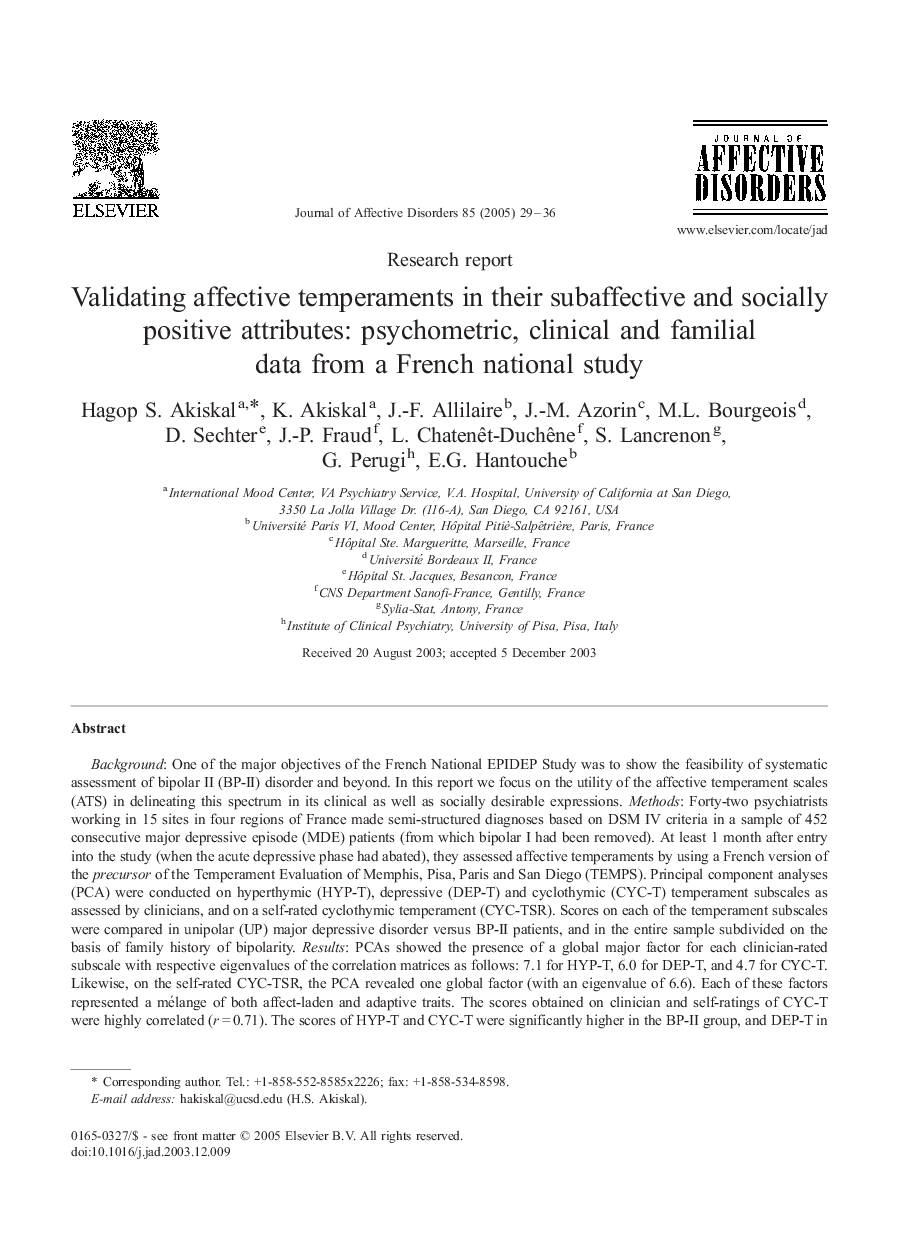| کد مقاله | کد نشریه | سال انتشار | مقاله انگلیسی | نسخه تمام متن |
|---|---|---|---|---|
| 9380717 | 1608235 | 2005 | 8 صفحه PDF | دانلود رایگان |
عنوان انگلیسی مقاله ISI
Validating affective temperaments in their subaffective and socially positive attributes: psychometric, clinical and familial data from a French national study
دانلود مقاله + سفارش ترجمه
دانلود مقاله ISI انگلیسی
رایگان برای ایرانیان
کلمات کلیدی
موضوعات مرتبط
علوم پزشکی و سلامت
پزشکی و دندانپزشکی
روانپزشکی و بهداشت روانی
پیش نمایش صفحه اول مقاله

چکیده انگلیسی
Background: One of the major objectives of the French National EPIDEP Study was to show the feasibility of systematic assessment of bipolar II (BP-II) disorder and beyond. In this report we focus on the utility of the affective temperament scales (ATS) in delineating this spectrum in its clinical as well as socially desirable expressions. Methods: Forty-two psychiatrists working in 15 sites in four regions of France made semi-structured diagnoses based on DSM IV criteria in a sample of 452 consecutive major depressive episode (MDE) patients (from which bipolar I had been removed). At least 1 month after entry into the study (when the acute depressive phase had abated), they assessed affective temperaments by using a French version of the precursor of the Temperament Evaluation of Memphis, Pisa, Paris and San Diego (TEMPS). Principal component analyses (PCA) were conducted on hyperthymic (HYP-T), depressive (DEP-T) and cyclothymic (CYC-T) temperament subscales as assessed by clinicians, and on a self-rated cyclothymic temperament (CYC-TSR). Scores on each of the temperament subscales were compared in unipolar (UP) major depressive disorder versus BP-II patients, and in the entire sample subdivided on the basis of family history of bipolarity. Results: PCAs showed the presence of a global major factor for each clinician-rated subscale with respective eigenvalues of the correlation matrices as follows: 7.1 for HYP-T, 6.0 for DEP-T, and 4.7 for CYC-T. Likewise, on the self-rated CYC-TSR, the PCA revealed one global factor (with an eigenvalue of 6.6). Each of these factors represented a mélange of both affect-laden and adaptive traits. The scores obtained on clinician and self-ratings of CYC-T were highly correlated (r=0.71). The scores of HYP-T and CYC-T were significantly higher in the BP-II group, and DEP-T in the UP group (P<0.001). Finally, CYC-T scores were significantly higher in patients with a family history of bipolarity. Conclusion: These data uphold the validity of the affective temperaments under investigation in terms of face, construct, clinical and family history validity. Despite uniformity of depressive severity at entry into the EPIDEP study, significant differences on ATS assessment were observed between UP and BP-II patients in this large national cohort. Self-rating of cyclothymia proved reliable. Adding the affective temperaments-in particular, the cyclothymic-to conventional assessment methods of depression, a more enriched portrait of mood disorders emerges. More provocatively, our data reveal socially positive traits in clinically recovering patients with mood disorders.
ناشر
Database: Elsevier - ScienceDirect (ساینس دایرکت)
Journal: Journal of Affective Disorders - Volume 85, Issues 1â2, March 2005, Pages 29-36
Journal: Journal of Affective Disorders - Volume 85, Issues 1â2, March 2005, Pages 29-36
نویسندگان
Hagop S. Akiskal, K. Akiskal, J.-F. Allilaire, J.-M. Azorin, M.L. Bourgeois, D. Sechter, J.-P. Fraud, L. Chatenêt-Duchêne, S. Lancrenon, G. Perugi, E.G. Hantouche,